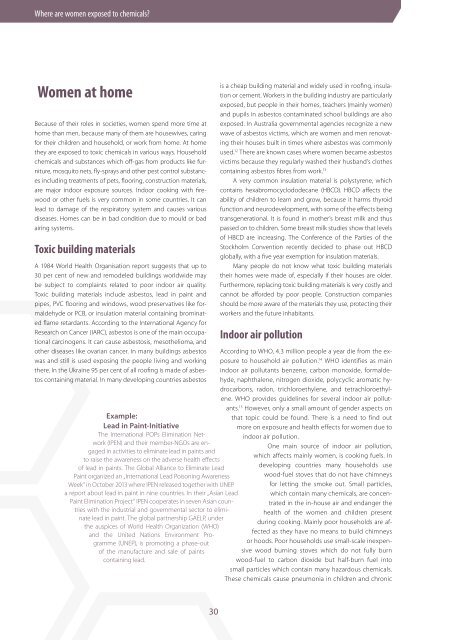Women and Chemicals
1ToENNR
1ToENNR
Create successful ePaper yourself
Turn your PDF publications into a flip-book with our unique Google optimized e-Paper software.
Where are women exposed to chemicals?<br />
<strong>Women</strong> at home<br />
Because of their roles in societies, women spend more time at<br />
home than men, because many of them are housewives, caring<br />
for their children <strong>and</strong> household, or work from home. At home<br />
they are exposed to toxic chemicals in various ways. Household<br />
chemicals <strong>and</strong> substances which off-gas from products like furniture,<br />
mosquito nets, fly-sprays <strong>and</strong> other pest control substances<br />
including treatments of pets, flooring, construction materials,<br />
are major indoor exposure sources. Indoor cooking with firewood<br />
or other fuels is very common in some countries. It can<br />
lead to damage of the respiratory system <strong>and</strong> causes various<br />
diseases. Homes can be in bad condition due to mould or bad<br />
airing systems.<br />
Toxic building materials<br />
A 1984 World Health Organisation report suggests that up to<br />
30 per cent of new <strong>and</strong> remodeled buildings worldwide may<br />
be subject to complaints related to poor indoor air quality.<br />
Toxic building materials include asbestos, lead in paint <strong>and</strong><br />
pipes, PVC flooring <strong>and</strong> windows, wood preservatives like formaldehyde<br />
or PCB, or insulation material containing brominated<br />
flame retardants. According to the International Agency for<br />
Research on Cancer (IARC), asbestos is one of the main occupational<br />
carcinogens. It can cause asbestosis, mesothelioma, <strong>and</strong><br />
other diseases like ovarian cancer. In many buildings asbestos<br />
was <strong>and</strong> still is used exposing the people living <strong>and</strong> working<br />
there. In the Ukraine 95 per cent of all roofing is made of asbestos<br />
containing material. In many developing countries asbestos<br />
Example:<br />
Lead in Paint-Initiative<br />
The International POPs Elimination Network<br />
(IPEN) <strong>and</strong> their member-NGOs are engaged<br />
in activities to eliminate lead in paints <strong>and</strong><br />
to raise the awareness on the adverse health effects<br />
of lead in paints. The Global Alliance to Eliminate Lead<br />
Paint organized an „International Lead Poisoning Awareness<br />
Week“ in October 2013 where IPEN released together with UNEP<br />
a report about lead in paint in nine countries. In their „Asian Lead<br />
Paint Elimination Project“ IPEN cooperates in seven Asian countries<br />
with the industrial <strong>and</strong> governmental sector to eliminate<br />
lead in paint. The global partnership GAELP, under<br />
the auspices of World Health Organization (WHO)<br />
<strong>and</strong> the United Nations Environment Programme<br />
(UNEP), is promoting a phase-out<br />
of the manufacture <strong>and</strong> sale of paints<br />
containing lead.<br />
is a cheap building material <strong>and</strong> widely used in roofing, insulation<br />
or cement. Workers in the building industry are particularly<br />
exposed, but people in their homes, teachers (mainly women)<br />
<strong>and</strong> pupils in asbestos contaminated school buildings are also<br />
exposed. In Australia governmental agencies recognize a new<br />
wave of asbestos victims, which are women <strong>and</strong> men renovating<br />
their houses built in times where asbestos was commonly<br />
used. 12 There are known cases where women became asbestos<br />
victims because they regularly washed their husb<strong>and</strong>’s clothes<br />
containing asbestos fibres from work. 13<br />
A very common insulation material is polystyrene, which<br />
contains hexabromocyclododecane (HBCD). HBCD affects the<br />
ability of children to learn <strong>and</strong> grow, because it harms thyroid<br />
function <strong>and</strong> neurodevelopment, with some of the effects being<br />
transgenerational. It is found in mother’s breast milk <strong>and</strong> thus<br />
passed on to children. Some breast milk studies show that levels<br />
of HBCD are increasing. The Conference of the Parties of the<br />
Stockholm Convention recently decided to phase out HBCD<br />
globally, with a five year exemption for insulation materials.<br />
Many people do not know what toxic building materials<br />
their homes were made of, especially if their houses are older.<br />
Furthermore, replacing toxic building materials is very costly <strong>and</strong><br />
cannot be afforded by poor people. Construction companies<br />
should be more aware of the materials they use, protecting their<br />
workers <strong>and</strong> the future inhabitants.<br />
Indoor air pollution<br />
According to WHO, 4.3 million people a year die from the exposure<br />
to household air pollution. 14 WHO identifies as main<br />
indoor air pollutants benzene, carbon monoxide, formaldehyde,<br />
naphthalene, nitrogen dioxide, polycyclic aromatic hydrocarbons,<br />
radon, trichloroethylene, <strong>and</strong> tetrachloroethylene.<br />
WHO provides guidelines for several indoor air pollutants.<br />
15 However, only a small amount of gender aspects on<br />
that topic could be found. There is a need to find out<br />
more on exposure <strong>and</strong> health effects for women due to<br />
indoor air pollution.<br />
One main source of indoor air pollution,<br />
which affects mainly women, is cooking fuels. In<br />
developing countries many households use<br />
wood-fuel stoves that do not have chimneys<br />
for letting the smoke out. Small particles,<br />
which contain many chemicals, are concentrated<br />
in the in-house air <strong>and</strong> endanger the<br />
health of the women <strong>and</strong> children present<br />
during cooking. Mainly poor households are affected<br />
as they have no means to build chimneys<br />
or hoods. Poor households use small-scale inexpensive<br />
wood burning stoves which do not fully burn<br />
wood-fuel to carbon dioxide but half-burn fuel into<br />
small particles which contain many hazardous chemicals.<br />
These chemicals cause pneumonia in children <strong>and</strong> chronic<br />
30


